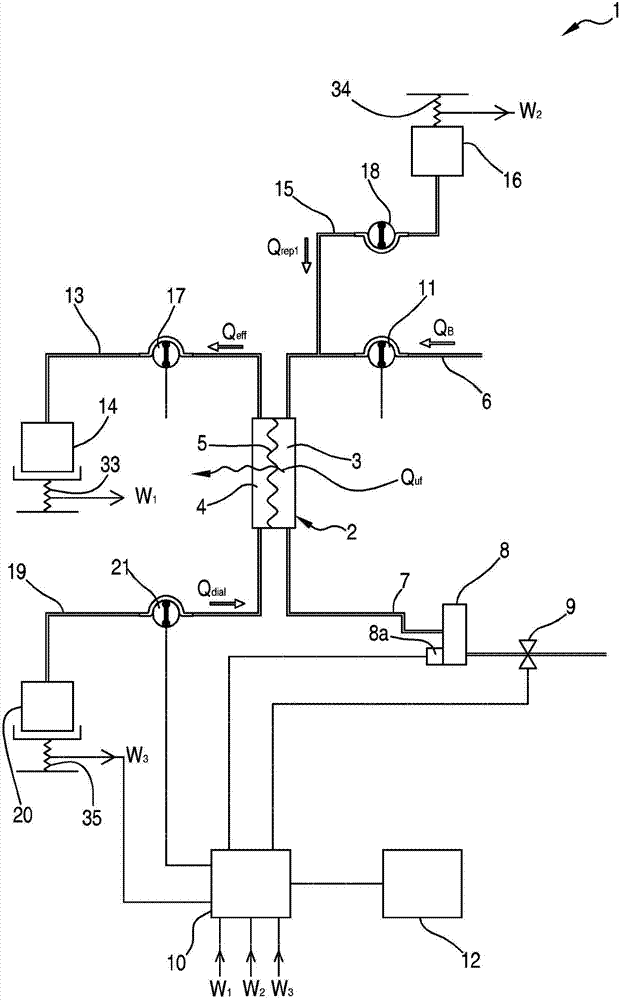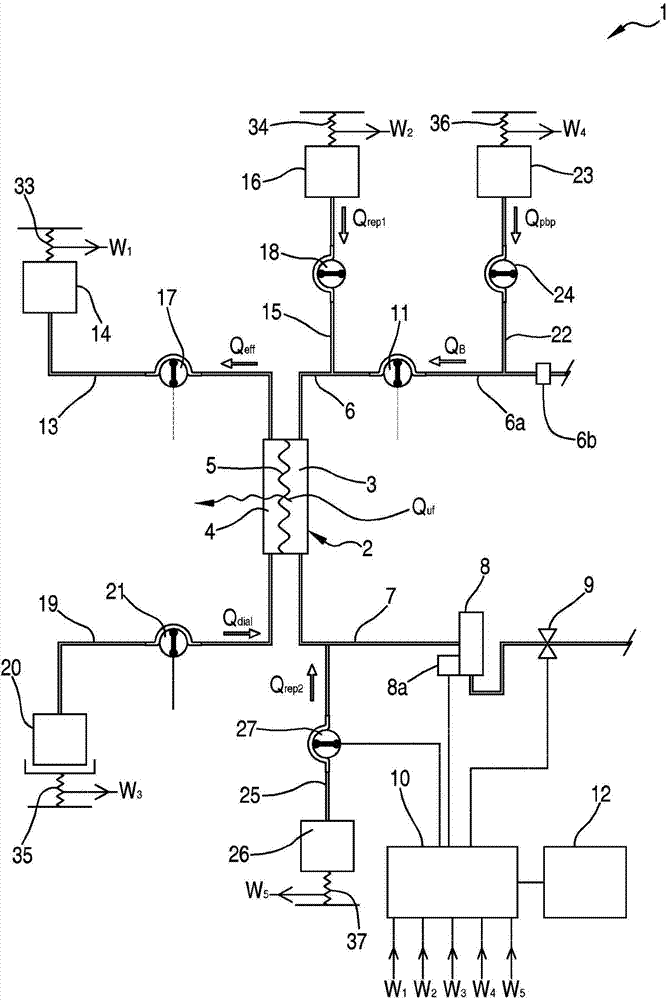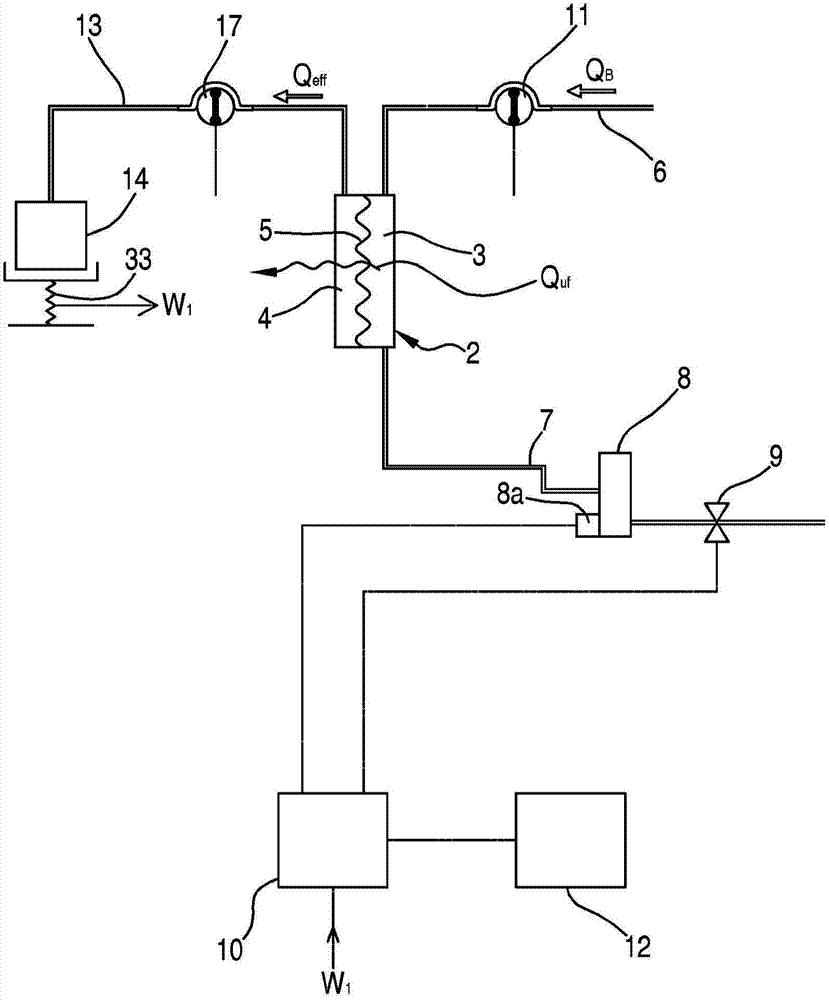Apparatus for extracorporeal treatment of blood
A technology for extracorporeal blood processing and blood, which is used in blood filtration, other medical devices, suction devices, etc.
- Summary
- Abstract
- Description
- Claims
- Application Information
AI Technical Summary
Problems solved by technology
Method used
Image
Examples
example 1
[0212] Figure 5 A first example of implementation of the control process already described herein above is shown.
[0213] In this embodiment, the control process includes:
[0214] - determined at the detection point T i previous time period T retro The value of the fluid removed from the patient within V pfr_removed ;
[0215] - determined at the detection point T i After the time period T prosp The value V of the fluid to be removed from the patient within pfr_need , so that at the detection point T i previous time period T retro and detection point (T i ) after the time period T prosp The total time period fluid withdrawal rate Q pfr The setting value of Q pfr_set ;exist Figure 5 middle, T retro equal to T prosp : Of course this can be the preferred choice, it should be noted that T retro can also be used with T prosp different.
[0216] - Setpoint Q based on fluid withdrawal rate pfr_set , at the detection point (T i ) after the time period T prosp ...
example 2
[0239] Image 6 A second example of implementation of the control process already described herein above is shown.
[0240] In this case, the process is aimed at achieving the most accurate removal of patient fluid within a predefined period of time. In this example, a number of time periods of constant duration ΔT are preset, starting at a preset time T00:
[0241] T 00 ; T 00 +ΔT;...;T 00 +k·ΔT
[0242] and end at the preset end time
[0243] T 00 +ΔT; T 00 +2ΔT;...;T 00 +(k+1)·ΔT.
[0244] In this variant, the purpose of the control unit 10 is to deliver precise indications of patient fluid removal within predefined time windows, for example to match staff shifts or simply "on the hour" (13:00, 14:00, 15:00, ...).
[0245] When calculating the instantaneous Q pfr_new , the "detection point T" can be completed in the following manner i ":
[0246] - at each processing interruption (downtime);
[0247] - at each flow setting change;
[0248] - at each predefin...
example 3
[0283] The following example is the same as example 2 (refer to image 3 with Image 6 ) similarly, showing the effective part T eff The calculation and use of , in this case by taking the detection point T i The effective fraction T is determined by reducing the duration of the subsequent time period by a first amount associated with the average bag change time expected to be spent in the following time period and by a second amount associated with downtime due to the alarm condition eff .
[0284] Apply algorithm (6) to image 3 means, assuming:
[0285] - The operator initially sets Q pfr_set =100ml / h;
[0286] - Predefined time windows: 0:00; 4:00; 8:00; 12:00; 16:00; 20:00;
[0287] - detection time T i :10:30;
[0288] - Fluid actually taken out in [4:00; 8:00] measured by scale 33 is V pfr(k-1) = 396ml;
[0289] - Fluid actually taken out in [4:00; 10:30] measured by scale 33 is V pfr(0) =245ml;
[0290] - The number of bag changes planned in [10:30; 12:00]...
PUM
 Login to View More
Login to View More Abstract
Description
Claims
Application Information
 Login to View More
Login to View More - R&D
- Intellectual Property
- Life Sciences
- Materials
- Tech Scout
- Unparalleled Data Quality
- Higher Quality Content
- 60% Fewer Hallucinations
Browse by: Latest US Patents, China's latest patents, Technical Efficacy Thesaurus, Application Domain, Technology Topic, Popular Technical Reports.
© 2025 PatSnap. All rights reserved.Legal|Privacy policy|Modern Slavery Act Transparency Statement|Sitemap|About US| Contact US: help@patsnap.com



